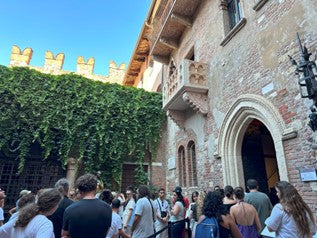
The Environmental Impact of Overtourism: How We Can Travel More Sustainably
Share
By Jennifer Cooper

Crammed into the small courtyard to catch a glimpse of the Romeo and Juliet balcony in Verona, Italy
Understanding Overtourism and its Consequences
On a recent trip to Italy, I saw firsthand the negative effects of overtourism. While the trip was amazing overall, the impact of too many tourists on the environment and local communities was hard to ignore. The United Nations defines sustainable tourism as a way of traveling that considers the long-term impact on the economy, society, and the environment. Unfortunately, as more people flock to popular destinations, this balance is getting harder to maintain.

Tourists in line to snatch a photo at a famed Instagram spot at Villa Monastero in Varenna, Lake Como Italy
Overcrowding is becoming a big problem, not only diminishing the quality of the tourist experience but also places immense strain on local environments and communities. Many destinations are grappling with increased pollution, damage to historical sites, and overcrowded spaces. Popular attractions now often come with long lines and high costs, beaches are packed, local markets have turned into tourist traps, and the demand for more accommodations is leading to the destruction of natural habitats and higher living costs for residents. One alarming statistic is that global tourism contributes to 8% of global carbon emissions. The prevalence of single-use plastics, such as the millions of plastic water bottles sold every minute, further exacerbates the environmental damage.
Personal Reflection of Overtourism’s Challenges

Aperitivo dinner prepared by locals at their house in the woods above Lake Como Italy
During my visit to Lake Como, a destination known for its beauty and celebrity appeal, I was struck by the contrast between the picturesque scenery and the challenges faced by locals due to overtourism. While I enjoyed a hike led by a local guide and had a chance to experience the authentic culture, I also learned about the difficulties locals face, such as price inflation and navigating through traffic congestion.
Worldwide Responses to the Overtourism Crisis
Unfortunately, Italy is not alone in facing these issues. Cities like Barcelona have seen such a surge in tourism that locals are protesting, demanding that something be done. In response, some cities are implementing measures such as bans, fines, and taxes to manage the number of visitors. For example, Venice introduced a tourist day tax to discourage day-trippers and banned large cruise ships from entering its canals.
Practical Steps for Sustainable Travel

Above the glitz and glam of Lake Como Italy
So, what can we as travelers do to mitigate our impact? Simple actions can make a big difference:
- Use reef-safe sunscreen to protect marine ecosystems.
- Carry a reusable water bottle to reduce plastic waste.
- Recycle whenever possible.
- Explore less-visited destinations to ease the burden on popular spots.
- Support local businesses by purchasing locally-made souvenirs, shopping at markets, hiring local guides, and eating at local restaurants - these options are often better and more affordable!
- Choose eco-friendly transportation to help offset your carbon emissions by flying less (trains, buses, and carpooling have lower emissions), opt for direct flights, use public transport, bike, or walk (instead of renting a car or using taxis)
- Opt for eco-friendly accommodations with sustainable practices such as energy-efficient buildings, renewable energy, or water conservation initiatives.
Conclusion: Preserving Destinations Through Sustainable Tourism
Sustainable tourism is challenging, but it's essential if we want to continue enjoying these beautiful places without harming them. By making more mindful choices, we can help ensure that travel remains a positive experience for everyone involved.
References:
Sustainable development (unwto.org)
